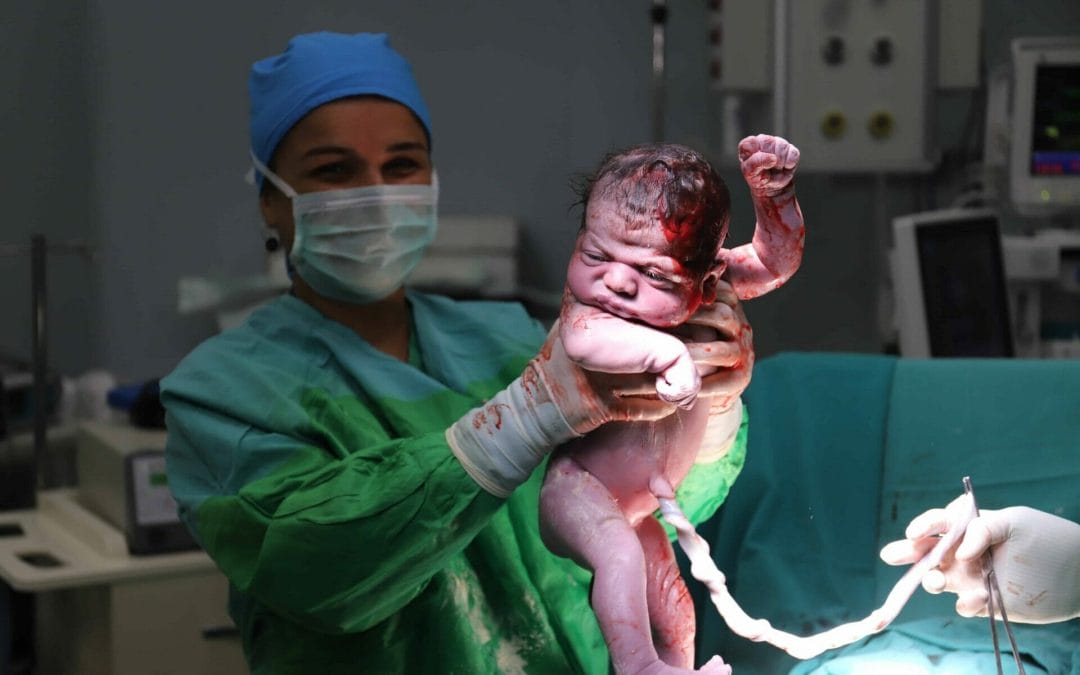Here are some common terms that you may hear during your labor and delivery, and what they mean:
Abruptio Placenta / Placental Abruption: the placenta has begun separating from the wall of the uterus before the baby is born.
Amniotic Fluid: the liquid that fills the sac surrounding the baby to keep it safe.
APGAR: stands for Appearance (color), Pulse (heartbeat), Grimace (reflex), Activity (muscle tone) and Respiration (breathing). It is used to measure the baby’s health outside the womb on a scale of 1 to 10.
Breech Presentation: When the position of the fetus is backwards, meaning that the buttocks or feet are coming first, rather than the head.
Cephalopelvic Disproportion (CPD): When the baby is too large to pass through the mother’s pelvis safely.
Cervidil: a type of medication that is used to ripen the cervix before an induction.
Cesarean: the process of delivering a baby by making an incision through the abdomen and uterus.
Colostrum: a white fluid that discharges from the breasts in the beginning stages of milk production, and is generally present in the final few weeks of pregnancy.
Complete Breech: when the baby’s buttocks present at the cervix and the legs are folded, reducing the possibility of a safe vaginal delivery.
Contraction: the tightening of the uterus which works to push the baby through the birth canal.
Crowned/Crowning: when the baby passes through the birth canal and the crown of the head is visible at the opening of the vagina.
Dilation: the amount of opening of the cervix in preparation for childbirth. A fully dilated cervix measures 10cm.
Effacement: the thinning of the cervix which occurs in preparation of birth, which is measured in percentages. A person who is 100% effaced is ready to begin pushing.
Engaged: when the baby’s presented part, which is usually the head settles into the pelvic cavity about a month before delivery.
Epidural: a method of anesthesia used as a pain management tool during labor and delivery. It involves a catheter fed through a needle into the dura space which is near spinal cord.
Episiotomy: a small incision which is made in the perineum in order to widen the vaginal opening in order to aid delivery.
Fetal Distress: occurs if the baby doesn’t have enough oxygen or if there is other complications.
Fontanelle: soft spots on the baby’s skull in between the unfused sections, which shift in order to allow the baby’s head to pass through the birth canal.
Forceps: instruments that are occasionally used to help ease the baby’s head out of the birth canal during delivery.
Frank Breech: when the baby’s buttocks are presenting first and the legs are straight up past the baby’s head.
Incontinence: not being able to control bodily functions, which is sometimes that can occur during late stages in pregnancy when the baby is putting heavy pressure on the bladder.
Induced Labor: when labor is started or sped up using a type of prostaglandin gel on the cervix or an IV drip of oxytocin or by rupturing the bag of membranes.
Jaundice: a condition that is common in newborns where the liver is not able to keep up with the processing of red blood cells, and causes a yellowing of the skin.
Labor: the process of regular contractions which dilate and efface the cervix.
Lightening: prior to labor, when the baby drops down into the pelvis.
Meconium: a greenish material that collects in the bowels of the fetus as it grows. Usually this substance is excreted after birth.
Neonatologist: a health care provider who specializes in caring for newborns.
NICU: stands for Neonatal Intensive Care Unit, a place where at risk babies are monitored.
Nubian: a synthetic pain relieve often used in labor and delivery.
Oxytocin: a hormone that stimulates contractions and milk creation.
Perineum: the tissue and muscle which is between the vagina and rectum.
Phenergan: a sedative that is often used to temper nausea and vomiting.
Placenta: the tissue that acts as connection between the mother and fetus, transporting blood and nutrients.
Placenta Previa: a condition when the placenta either partially or completely covers the cervix, which can interfere with a vaginal delivery.
Posterior: when the baby is facing up during delivery, as opposed to a normal deliver which is anterior, or facing down.
Post Partum: after childbirth
Post-Term: a pregnancy that lasts beyond 42 weeks.
Preterm: when a baby is born before 37 weeks.
Prostaglandin Cream: a medication that helps to ripen the cervix before labor is induced.
Ruptured Membranes: when the bag of water around the baby breaks, resulting in a slow leak of water or a gush.
Speculum: instrument that is inserted in the vagina in order to open it wider so that the cervix can be viewed.
Timing Contractions: the time that passes from the beginning of one contraction to the beginning of the next one.
Transverse: when the baby is laying horizontally in the womb. If he or she cannot be turned then a cesarean section will be performed for delivery.
Umbilical Cord: the cord that links the placenta and the baby, and is used to transport blood, oxygen and nutrients between the baby an its mother.
Vacuum Extractor: a small instrument that suctions to the baby’s head during delivery and is used to help coax the baby out of the birth canal.

